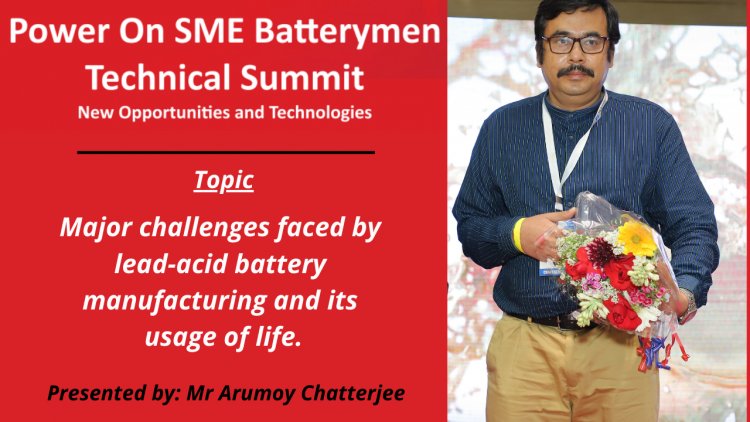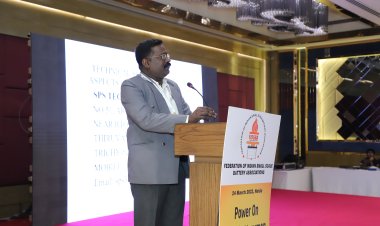Major challenges facing by lead-acid battery manufacturing and its usage of life by Mr. Arumoy Chatterjee
There are two processes gravity casting and pressure die casting. In gravity casting, the main weakness is the weak grain structure and bonding between grains which cause several defects like crack, weak wire, brittleness etc. This causes more corrosion during usage and results in premature failure

Tubular BatteryChallenge in manufacturing :Manufacturing defect during casting of the spine. Manufacturing defect during casting of spine Common defects and challenges faced during manufacturing spine are mainly casting defects. There are two processes gravity casting and pressure die casting. In gravity casting, the main weakness is the weak grain structure and bonding between grains which cause several defects like crack, weak wire, brittleness etc. This causes more corrosion during usage and results in premature failure. Also during charge and discharge the mechanical strength of gravity caste spine does not withstand the stress build because of repeated expansion and contraction. Another process adopted is pressure die casting. The cost of a pressure die casting machine is much higher than the gravity casting machine as well as higher operating cost. There are some challenges to the pressure die casting process also. The common defects are blowholes, cracks, and brittle spine, especially for the longer spine. The machine must be well maintained otherwise the hydraulic system and lead pump will malfunction, which causes one of the defects to blowholes. The hidden blowhole may cause the particular failure of the spine during usage. The mould and its cooling system must be well maintained otherwise the distortion of the spine and crack may occur during casting. But thanks to technology, adopting the pressure die casting process which gives far better quality of spine than gravity casting. Oxide filling homogeneous packed density all along the tube longitudinally.Known three popular oxide filling processes are powder filling, slurry filling and paste filling. The cheaper is powder filling. As we know the powder filling process starts from the portion (A), so the powder packing process will start from the portion (C). When portion (B) will be packed filled at that time the portion (C) already packed filled in more packed density than a portion (B), which causes the inequality of packed density as well as porosity. For longer plates, this variation was found remarkable. This results in premature failure. Oxide filling by slurry filling and paste filling.It gives a cleaner manufacturing environment. Weight variation plate to plate is very nominal, which will not affect the performance of the battery during usage. Packed density all along the length is controllable and variation is very minimum. Sulfation during picklingThis is a big challenge and highly process parameter dependent. For a deep discharge battery, a positive plate is required to form lead tetrabasic sulphate, which converts to alfa PbO2 and which takes a major part in skeleton structure and that is highly required in deep discharge application. Without reaching more than 70 degrees temperature the tri tetrabasic sulphate formation is not remarkable. Challenges in the usage of lifeSome vital reasons for lead-acid battery failure and challenges faced in their usage of life:- Due to positive plate degradation which is caused by grid corrosion and plate shedding. Positive grid corrosion can be caused by grid alloy, grid casting conditions and active material composition. Shedding of active material can be caused by battery construction, active material structure, battery cycles, DOD and charge method. Due to water loss in electrolytes. If the oxygen evolution rate is more than the oxygen recombination then water loss will happen. Charge acceptance is one of the big challenges during usage of life. During charging the lead sulphate is a very poor conductor. So to improve the electronic conductivity carbon is being added. The carbon accommodates lead sulphate grains and passes the current. The amorphous carbon is a poor conductor. So the quality of carbon and dry mixing during paste mixing have a vital role in that. The carbon also improves the specific surface area of the plate. But addition f carbon above a certain %-age gives water loss. Some failure modes of a negative plate are Irreversible formation of lead sulphate in the active mass. a)&b) Irreversible formation of lead sulphate in the active mass and sulfation. During the usage of the battery, it is desirable to form smaller lead sulphate crystals, which can easily electrochemically react during charging and convert to lead. This sulphate is called soft sulfation. On the other hand, the bigger crystal of lead sulphate can not react during charging and can not convert to lead resulting from the capacity loss. c) Agglomeration of finely divided lead. d) Passivation of the negative grid surface. The corrosion of the grid and active material utilization is correlated. Positive active material PbO2(10 to the power 3 to the power 4 S/m) degenerates semi-conductor and has a lower conductivity than metal Pb(10 to the power 6 to the power 7 S/m). Deposit that active mass volume between two wires of spine or grid has to be used for current path-way before the current can reach the metal bar. So 1. Optimize the α value: Lower α value results in a higher PAM. But grid weight can’t be reduced below a certain level, so there needs optimization. 2. Optimize the ϓ value: Normally higher ϓ value could give a lower battery power output and lower PAM utilization and vice versa. So there needs optimization. 3. Consider corrosion resistance: Corrosion resistance of lead alloy need to consider during the selection of lead alloy. In practice, to enhance the formation of positive plates, some additives need to add to the positive plates. These additives can increase the conductivity of the cured paste and also gives benefit, the uniform current distribution throughout the entire PbO2 layer. These additives compounds should be chemically stable in sulfuric acid solution. I experienced working with some Indian and Abroad company adopted ULKA Gold special additives to overcome this issue and got remarkable results. Self-discharge:- Self-discharge is one of the big challenges during charged finished battery storage. The equilibrium potential of a PbO2/PbSO4electrode is 0.6 volts more positive than that of an oxygen H2O/O2 electrode in a positive electrode. At the negative electrode, the electrode potential of Pb/PbSO4 is 0,5 V more negative than that of the H2/H+ couple, which can drive the self-discharge process and consume the Pb and PbO2. The self discharges highly depend on temperature, additives to the active mass, electrolyte formulation and grid alloy composition. Presented By:Mr Arumoy ChatterjeeGave a very informative presentation at the 16th Power On SME Batterymen Technical Summit that happened on the 24th of march.
Mr Arumoy Chatterjee has rich experience in lead-acid manufacturing since the year 1991. |
























